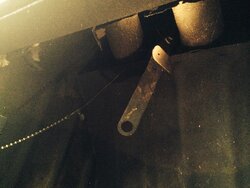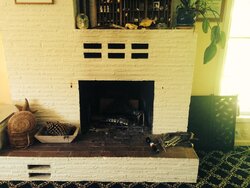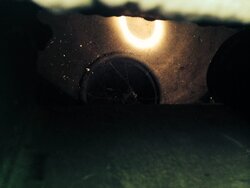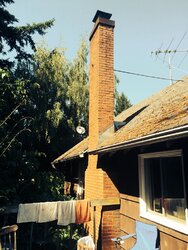Ugh this is embarrassing but I can't figure out how to insert a line break in this editor? Return does nothing. Sorry for the long form paragraph Hi, my name is Elizabeth, and I apologize in advance for not knowing the technical terms for some of this stuff. I've done as much research as I could over the internet but its pretty confusing for someone with no background in masonry or constructions. And yes I read the rule about no specific DIY instructions. I'm not asking for instructions, just for someone to paint me a picture of how bleak my situation is. 
So I'm renting this house and it is from the 1930s and it was this ENORMOUS fireplace. I'll include a picture, but it seriously takes up the entire wall. It's an exterior wall. The chimney goes really high up into the air outside, without going through any more stories, and it has a cap thing on top, I assume to keep birds and rain out? It is anchored to the roof with a thick cable.Inside the fireplace itself is a very gross, rusted out metal insert thing which I believe, based on my Googling, is a Heatilator or similar. This theory is supported by the presence of some intentionally missing bricks along the floor line, and some up above, I assume these were the "in" and "out" vents for the airflow which was supposed to go behind and around the firebox?
Since the top of the firebox and the damper and all the upper mechanism is rusted all to hell, I'm guessing that smoke/C02 can also come out of those vents now. There is some soot on the bricks above the vents to support this theory. Inside the fireplace, there is the old rusted lever which originally controlled the damper and now isn't even really attached to anything, it's just hanging there. There is also a long steel cord, and a place to anchor the cord. I believe this controls a SECONDARY damper, one that was installed possibly to compensate for the original one being rusted through? When I pull it, I can hear a "ch-chunk!" noise from way up in the top of the chimney, and the same when I let it go, so I think this secondary damper is working just fine.
We lit a fire in the fireplace only once, and it seemed to *sort of* work. A little bit of smoke came out the vents in the front, just like I thought it would, but probably 90% of the smoke went out the chimney- I went outside to check. It's possible that if I had let the fire go longer, and really get going, all the smoke would have gone out the chimney, but it set off the fire alarm and I chickened out and put it out.
From what I have read, it seems like these old Heatilators are pretty common, and so is the problem I am having with them. I am getting a lot of conflicting information about what would need to be done, though. Some people say, "oh, just cut it out yourself with a Sawzall" (which I have!) "and stick a wood-burning insert in there, and you'll be fine" but some people say it needs to be "torched" out and that any wood-burning insert would require the flue itself to be re-done? Some people say it's incredibly dangerous to try and pull out an old Heatilator yourself because some of the flue bricks might be resting on it. Some people say it's easy and you can just rip it out and build a new hearth yourself with firebrick and no masonry experience. That doesn't sound accurate to me?Anyway, we're renting the house, and our landlord is a cheapskate, so probably we won't be able to hire a contractor. I'll probably end up just having to put flowers or something in there, which is *such* a pity because the fireplace is gorgeous and awesome and I already have a ton of firewood.
I read that you have a rule against DIY requests, so I'm not asking for instructions on how to do this project myself, which I probably won't do anyway, because it sounds terrifying. I guess I'm hoping against hope that someone on here can clarify for me- HOW dangerous is it to rip out a metal insert like this yourself?Can a wood-burning insert just be inserted as-is into the chimney that would be left after an insert is removed? The pipe thing on top could just go up the flue without any added insulation or anything? That sounds insane to me, but I don't know how flues work. Are there different kinds of chimneys, some that would require additional insulation, and some that wouldn't? Someone mentioned pre-fab chimneys, and I don't know what that is. If somehow we got the insert out, how would I be able to tell, from looking at the inside of the chimney, whether or not it is the sort of chimney that it is safe to use a wood stove in?It's totally dangerous for me to use this fireplace as it is, right? Like even though most of the smoke went out the chimney, I still feel like, since part of it is damaged, that could be dangerous. What if there was some sort of insulation in-between the insert and the brick that is now exposed to flames and is flammable and catches the whole damn chimney on fire? Is that possible? Could something on the inside be flammable? Probably, huh?
This is the most important question:-->If I get a chimneysweep to come and clean the flue out (I have a Groupon) and then I light a fire again, and leave it going a little longer, and all the smoke DOES indeed go up the chimney, and the fire alarm and C02 detectors do not go off- would that then mean that this fireplace is then safe to use as-is, or is it likely still quite dangerous? Is it still a risk for some other dangerous thing like a chimney fire or collapsing in on itself or something simply because of the presence of this rusted-out ancient machinery? I can't just ignore it, can I? <---And what would you do? Assume for the purposes of this discussion that you are an impoverished but creative and resourceful young family who is worried about being very cold in the Oregon winter this year Would you just invest in some blankets? Have I a recourse? How did it get to be 10:30 and I'm in a fireplace forum? How did I get here?
Would you just invest in some blankets? Have I a recourse? How did it get to be 10:30 and I'm in a fireplace forum? How did I get here?  Anyway any further light you could shed on this subject would be lovely. Thanks for your time, I know this was longwinded and rambling. Sorry. <3 Elizabeth
Anyway any further light you could shed on this subject would be lovely. Thanks for your time, I know this was longwinded and rambling. Sorry. <3 Elizabeth





So I'm renting this house and it is from the 1930s and it was this ENORMOUS fireplace. I'll include a picture, but it seriously takes up the entire wall. It's an exterior wall. The chimney goes really high up into the air outside, without going through any more stories, and it has a cap thing on top, I assume to keep birds and rain out? It is anchored to the roof with a thick cable.Inside the fireplace itself is a very gross, rusted out metal insert thing which I believe, based on my Googling, is a Heatilator or similar. This theory is supported by the presence of some intentionally missing bricks along the floor line, and some up above, I assume these were the "in" and "out" vents for the airflow which was supposed to go behind and around the firebox?
Since the top of the firebox and the damper and all the upper mechanism is rusted all to hell, I'm guessing that smoke/C02 can also come out of those vents now. There is some soot on the bricks above the vents to support this theory. Inside the fireplace, there is the old rusted lever which originally controlled the damper and now isn't even really attached to anything, it's just hanging there. There is also a long steel cord, and a place to anchor the cord. I believe this controls a SECONDARY damper, one that was installed possibly to compensate for the original one being rusted through? When I pull it, I can hear a "ch-chunk!" noise from way up in the top of the chimney, and the same when I let it go, so I think this secondary damper is working just fine.
We lit a fire in the fireplace only once, and it seemed to *sort of* work. A little bit of smoke came out the vents in the front, just like I thought it would, but probably 90% of the smoke went out the chimney- I went outside to check. It's possible that if I had let the fire go longer, and really get going, all the smoke would have gone out the chimney, but it set off the fire alarm and I chickened out and put it out.
From what I have read, it seems like these old Heatilators are pretty common, and so is the problem I am having with them. I am getting a lot of conflicting information about what would need to be done, though. Some people say, "oh, just cut it out yourself with a Sawzall" (which I have!) "and stick a wood-burning insert in there, and you'll be fine" but some people say it needs to be "torched" out and that any wood-burning insert would require the flue itself to be re-done? Some people say it's incredibly dangerous to try and pull out an old Heatilator yourself because some of the flue bricks might be resting on it. Some people say it's easy and you can just rip it out and build a new hearth yourself with firebrick and no masonry experience. That doesn't sound accurate to me?Anyway, we're renting the house, and our landlord is a cheapskate, so probably we won't be able to hire a contractor. I'll probably end up just having to put flowers or something in there, which is *such* a pity because the fireplace is gorgeous and awesome and I already have a ton of firewood.
I read that you have a rule against DIY requests, so I'm not asking for instructions on how to do this project myself, which I probably won't do anyway, because it sounds terrifying. I guess I'm hoping against hope that someone on here can clarify for me- HOW dangerous is it to rip out a metal insert like this yourself?Can a wood-burning insert just be inserted as-is into the chimney that would be left after an insert is removed? The pipe thing on top could just go up the flue without any added insulation or anything? That sounds insane to me, but I don't know how flues work. Are there different kinds of chimneys, some that would require additional insulation, and some that wouldn't? Someone mentioned pre-fab chimneys, and I don't know what that is. If somehow we got the insert out, how would I be able to tell, from looking at the inside of the chimney, whether or not it is the sort of chimney that it is safe to use a wood stove in?It's totally dangerous for me to use this fireplace as it is, right? Like even though most of the smoke went out the chimney, I still feel like, since part of it is damaged, that could be dangerous. What if there was some sort of insulation in-between the insert and the brick that is now exposed to flames and is flammable and catches the whole damn chimney on fire? Is that possible? Could something on the inside be flammable? Probably, huh?
This is the most important question:-->If I get a chimneysweep to come and clean the flue out (I have a Groupon) and then I light a fire again, and leave it going a little longer, and all the smoke DOES indeed go up the chimney, and the fire alarm and C02 detectors do not go off- would that then mean that this fireplace is then safe to use as-is, or is it likely still quite dangerous? Is it still a risk for some other dangerous thing like a chimney fire or collapsing in on itself or something simply because of the presence of this rusted-out ancient machinery? I can't just ignore it, can I? <---And what would you do? Assume for the purposes of this discussion that you are an impoverished but creative and resourceful young family who is worried about being very cold in the Oregon winter this year
 Would you just invest in some blankets? Have I a recourse? How did it get to be 10:30 and I'm in a fireplace forum? How did I get here?
Would you just invest in some blankets? Have I a recourse? How did it get to be 10:30 and I'm in a fireplace forum? How did I get here?  Anyway any further light you could shed on this subject would be lovely. Thanks for your time, I know this was longwinded and rambling. Sorry. <3 Elizabeth
Anyway any further light you could shed on this subject would be lovely. Thanks for your time, I know this was longwinded and rambling. Sorry. <3 Elizabeth



Last edited by a moderator:

